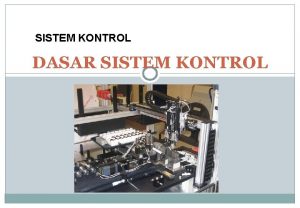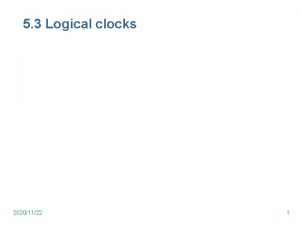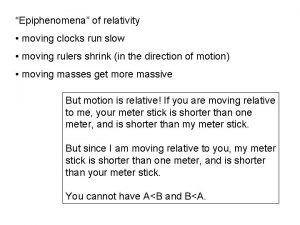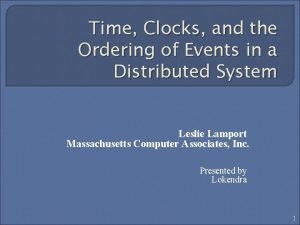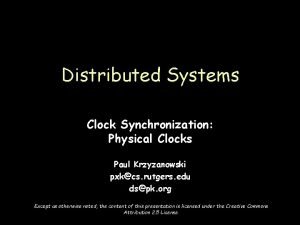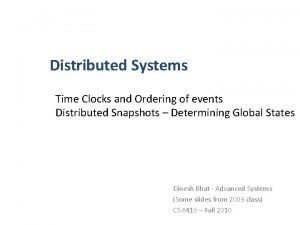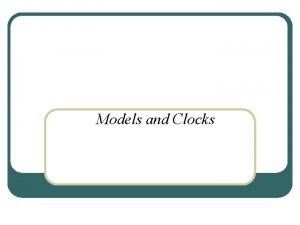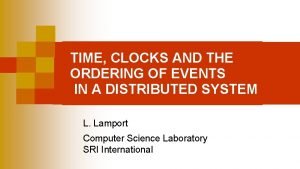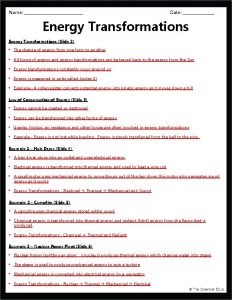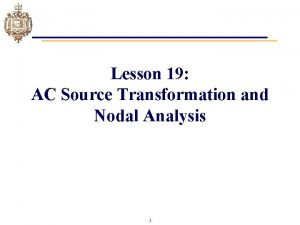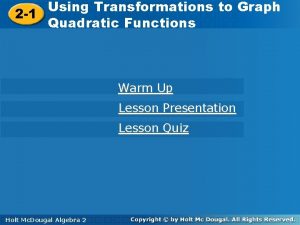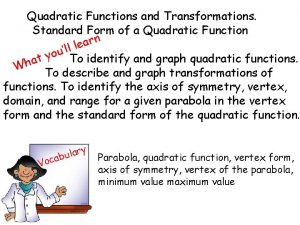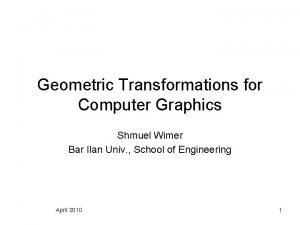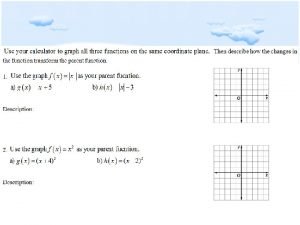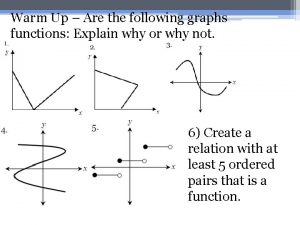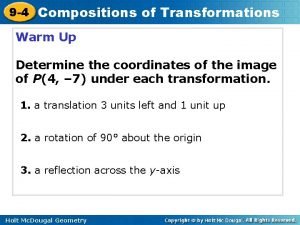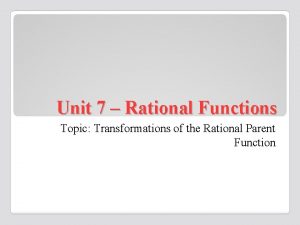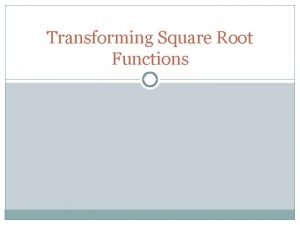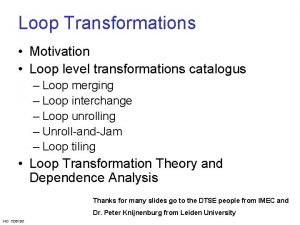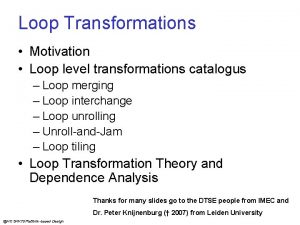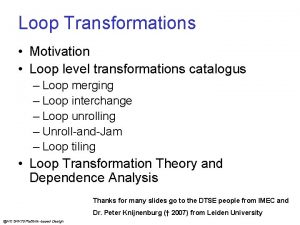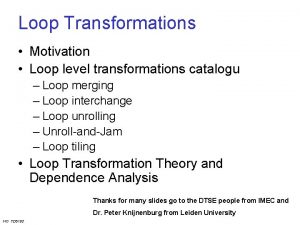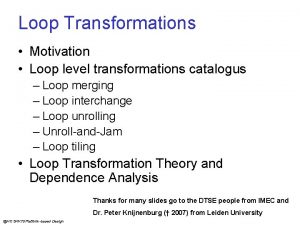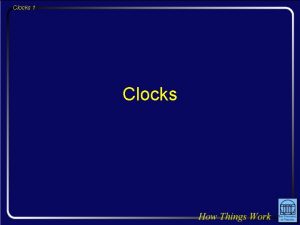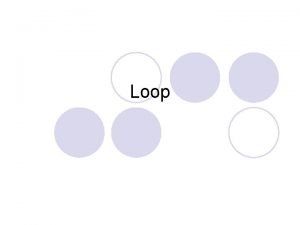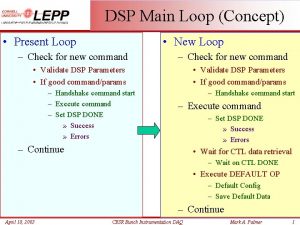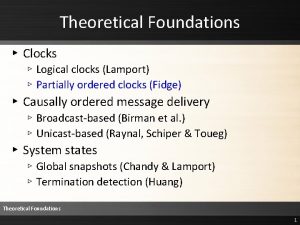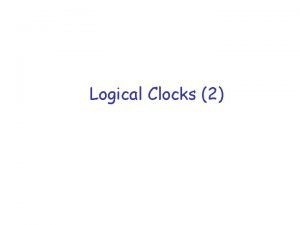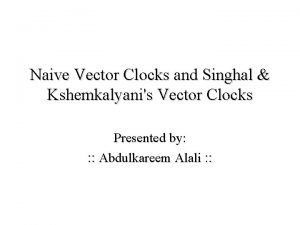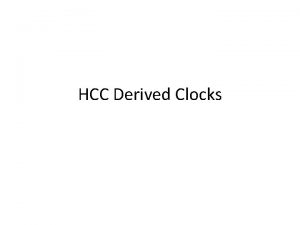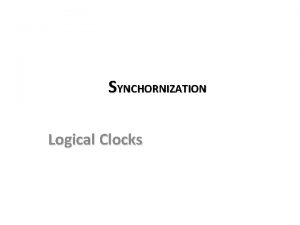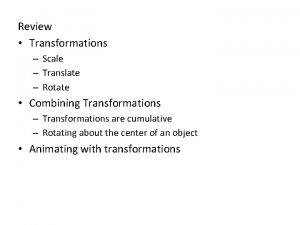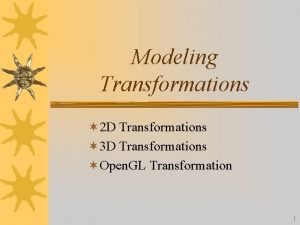Revisiting Loop Transformations with X 10 Clocks Tomofumi







































- Slides: 39

Revisiting Loop Transformations with X 10 Clocks Tomofumi Yuki Inria / LIP / ENS Lyon X 10 Workshop 2015

The Problem n The Parallelism Challenge n cannot escape going parallel n parallel programming is hard n automatic parallelization is limited n There won’t be any Silver Bullet n X 10 as a partial answer n high-level language with parallelism in mind n features to control parallelism/locality X 10 Workshop 2015 2

Programming with X 10 n Small set of parallel constructs n finish/async n clocks n at (places), atomic, when n Can be composed freely n Interesting for both programmer and compilers n also challenging But, it seems to be under-utilized X 10 Workshop 2015 3

This Paper n Exploring how to use X 10 clocks expressivity performance alternative“usual” way X 10 Workshop 2015 4

Context: Loop Transformations n Key to expose parallelism n some times it’s easy for i for j X[i] +=. . . n for i forall j X[i] +=. . . but not always for i = 0. . N for j = 1. . M X[j] = foo(X[j-1], X[j+1]); for i = 1. . 2 N+M forall j = /*complex bounds*/ X[j] = foo(X[2*j-i-1], X[2*j-i+1]); X 10 Workshop 2015 5

Automatic Parallelization n Very sensitive to inputs for (i=1; i<N; i++) for (j=1; j<M; j++) x[i][j] = x[i-1][j] + x[i][j-1]; for (i=1; i <N-1; i++) for (j=1; j<M-1; j++) y[i][j] = y[i-1][j] + y[i][j-1] + x[i+1][j+1]; for (t 1=2; t 1<=3; t 1++) { lbp=1; ubp=t 1 -1; #pragma omp parallel for private(lbv, ubv, t 3) for (t 2=lbp; t 2<=ubp; t 2++) { S 1((t 1 -t 2), t 2); } } for (t 1=M+1; t 1<=N; t 1++) { S 1((t 1 -1), 1); lbp=2; ubp=M-1; #pragma omp parallel for private(lbv, ubv, t 3) for (t 2=lbp; t 2<=ubp; t 2++) { S 1((t 1 -t 2), t 2); S 2((t 1 -t 2 -1), (t 2 -1)); } } for (t 1=N+1; t 1<=M; t 1++) { lbp=t 1 -N+1; ubp=t 1 -2; #pragma omp parallel for private(lbv, ubv, t 3) for (t 2=lbp; t 2<=ubp; t 2++) { S 1((t 1 -t 2), t 2); S 2((t 1 -t 2 -1), (t 2 -1)); } S 1(1, (t 1 -1)); } } for (t 1=max(M+1, N+1); t 1<=N+M-2; t 1++) { lbp=t 1 -N+1; ubp=M-1; #pragma omp parallel for private(lbv, ubv, t 3) for (t 2=lbp; t 2<=ubp; t 2++) { S 1((t 1 -t 2), t 2); S 2((t 1 -t 2 -1), (t 2 -1)); } } very difficult to understand trust it or not use it for (t 1=4; t 1<=min(M, N); t 1++) { S 1((t 1 -1), 1); lbp=2; ubp=t 1 -2; #pragma omp parallel for private(lbv, ubv, t 3) for (t 2=lbp; t 2<=ubp; t 2++) { S 1((t 1 -t 2), t 2); S 2((t 1 -t 2 -1), (t 2 -1)); } S 1(1, (t 1 -1)); } X 10 Workshop 2015 6

Expressing with Clocks n Goal: retain the original structure async for (i=1; i<N; i++) advance; async for (j=1; j<M; j++) x[i][j] = x[i-1][j] + x[i][j-1]; advance; async for (i=1; i <N-1; i++) advance; async for (j=1; j<M-1; j++) y[i][j] = y[i-1][j] + y[i][j-1] + x[i+1][j+1]; advance; X 10 Workshop 2015 7

Expressing with Clocks n Goal: retain the original structure async for (i=1; i<N; i++) advance; async for (j=1; j<M; j++) x[i][j] = x[i-1][j] + x[i][j-1]; advance; async for (i=1; i <N-1; i++) advance; async for (j=1; j<M-1; j++) y[i][j] = y[i-1][j] + y[i][j-1] + x[i+1][j+1]; advance; X 10 Workshop 2015 8

Expressing with Clocks n Goal: retain the original structure async for (i=1; i<N; i++) advance; 1. make async for (j=1; j<M; j++) x[i][j] = x[i-1][j] + x[i][j-1]; advance; async for (i=1; i <N-1; i++) advance; async for (j=1; j<M-1; j++) y[i][j] = y[i-1][j] + y[i][j-1] + x[i+1][j+1]; advance; many iterations parallel X 10 Workshop 2015 9

Expressing with Clocks n Goal: retain the original structure async for (i=1; i<N; i++) advance; 1. make many iterations async for (j=1; j<M; j++) x[i][j] = x[i-1][j] + x[i][j-1]; advance; 2. order them by asynchronizations for (i=1; i <N-1; i++) advance; async for (j=1; j<M-1; j++) y[i][j] = y[i-1][j] + y[i][j-1] + x[i+1][j+1]; advance; parallel X 10 Workshop 2015 10

Expressing with Clocks n Goal: retain the original structure async for (i=1; i<N; i++) advance; 1. make many iterations parallel async for (j=1; j<M; j++) x[i][j] = x[i-1][j] + x[i][j-1]; advance; 2. order them by asynchronizations for (i=1; i <N-1; i++) advance; async compound effect: parallelism for (j=1; j<M-1; j++) y[i][j] = y[i-1][j] + y[i][j-1] + similar x[i+1][j+1]; to those with loop trans. advance; X 10 Workshop 2015 11

Outline n Introduction n X 10 Clocks n Examples n Discussion X 10 Workshop 2015 12

clocks vs barriers n Barriers can easily deadlock //P 1 barrier; S 0; barrier; //P 2 barrier; S 1; n Clocks are more dynamic //P 1 advance; S 0; advance; //P 2 advance; S 1; 13

clocks vs barriers n Barriers can easily deadlock //P 1 barrier; S 0; barrier; deadlock //P 2 barrier; S 1; n Clocks are more dynamic //P 1 advance; S 0; advance; //P 2 advance; S 1; 14

clocks vs barriers n Barriers can easily deadlock //P 1 barrier; S 0; barrier; deadlock //P 2 barrier; S 1; n Clocks are more dynamic //P 1 advance; S 0; advance; OK //P 2 advance; S 1; 15

Dynamicity of Clocks n Implicit Syntax clocked finish for (i=1: N) clocked async { for (j=i: N) advance; S 0; } Creation of a clock Each process is registered Sync registered processes Each process is un-registered n The process creating a clock is also registered 16

Dynamicity of Clocks n Implicit Syntax clocked finish for (i=1: N) clocked async { for (j=i: N) advance; S 0; } n Each process waits until all processes starts n The primary process has to terminate first 17

n Implicit Syntax activ ity 1 Dynamicity of Clocks clocked finish for (i=1: N) clocked async { for (j=i: N) advance; S 0; } n Each process waits until all processes starts n The primary process has to terminate first 18

activ n Implicit Syntax ity 1 activ ity 2 Dynamicity of Clocks clocked finish for (i=1: N) clocked async { for (j=i: N) advance; S 0; } n Each process waits until all processes starts n The primary process has to terminate first 19

activ n Implicit Syntax ity 1 activ ity 2 activ ity 3 activ ity 4 activ ity 5 activ ity 6 Dynamicity of Clocks clocked finish for (i=1: N) clocked async { for (j=i: N) advance; S 0; } n Each process waits until all processes starts n The primary process has to terminate first 20

Dynamicity of Clocks n Implicit Syntax clocked finish for (i=1: N) { clocked async { for (j=i: N) advance; S 0; } advance; } n The primary process calls advance each time n Different synchronization pattern 21

Dynamicity of Clocks n Implicit Syntax clocked finish for (i=1: N) { clocked async { for (j=i: N) advance; S 0; } advance by primary activity n The primary process calls advance each time n Different synchronization pattern 22

activ n Implicit Syntax ity 1 activ ity 2 activ ity 3 activ ity 4 activ ity 5 activ ity 6 Dynamicity of Clocks clocked finish for (i=1: N) { clocked async { for (j=i: N) advance; S 0; } advance by primary activity n The primary process calls advance each time n Different synchronization pattern 23

Outline n Introduction n X 10 Clocks n Examples n Discussion X 10 Workshop 2015 24

Example: Skewing n Skewing the loops is not easy for (i=1: N) for (j=1: N) h[i][j] = foo(h[i-1][j], h[i-1][j-1], h[i][j-1]) skewing 25

Example: Skewing n Skewing the loops is not easy for (i=1: 2 N-1) forall (j=max(1, i-N): min(N, i-1)) h[i][j] = foo(h[(i-j)-1][j], h[(i-j)-1][j-1], h[(i-j)][j-1]) skewing 26

Example: Skewing n Skewing the loops is not easy for (i=1: 2 N-1) forall (j=max(1, i-N): min(N, i-1)) h[i][j] = foo(h[(i-j)-1][j], h[(i-j)-1][j-1], h[(i-j)][j-1]) changes to loop bounds and indexing skewing 27

Example: Skewing n Equivalent parallelism without changing loops clocked finish for (i=1: N) { clocked async for (j=1: N) { h[i][j] = foo(h[i-1][j], h[i-1][j-1], h[i][j-1]); advance; } 28

Example: Skewing n Equivalent parallelism without changing loops clocked finish for (i=1: N) { clocked async for (j=1: N) { h[i][j] = foo(h[i-1][j], h[i-1][j-1], h[i][j-1]); advance; } locally sequential the launch of the entire block is deferred 29

Example: Skewing n You can have the same skewing clocked finish for (j=1: N) { clocked async for (i=1: N) { h[i][j] = foo(h[i-1][j], h[i-1][j-1], h[i][j-1]); advance; } skewing 30

Example: Skewing n You can have the same skewing clocked finish for (j=1: N) { note: interchange clocked async outer parallel loop with clocks for (i=1: N) { h[i][j] = foo(h[i-1][j], h[i-1][j-1], h[i][j-1]); advance; } skewing 31

Example: Skewing n You can have the same skewing clocked finish for (j=1: N) { clocked async for (i=1: N) { h[i][j] = foo(h[i-1][j], h[i-1][j-1], h[i][j-1]); advance; } skewing 32

Example: Loop Fission n Common use of barriers forall (i=1: N) S 1; S 2; forall (i=1: N) S 1; forall (i=1: N) S 2; for (i=1: N) async { S 1; S 2; } for (i=1: N) async { S 1; advance; S 2; } X 10 Workshop 2015 33

Example: Loop Fusion n Removes all the parallelism for (i=1: N) S 1; for (i=1: N) S 2; for (i=1: N) S 1; S 2; async for (i=1: N) S 1; advance; async for (i=1: N) S 2; advance; X 10 Workshop 2015 34

Example: Loop Fusion n Sometimes fusion is not too simple for (i=1: N-1) S 1(i); for (i=2: N) S 2(i); code structure stays # of advance control S 1(1); for (i=2: N-1) S 1(i); S 2(N); async for (i=1: N-1) S 1; advance; async for (i=2: N) S 2; advance; X 10 Workshop 2015 35

What can be expressed? n Limiting factor: parallelism n difficult to use for sequential loop nests n works for wave-front parallelism n Intuition n clocks defer execution n deferring parent activity has cumulative effect X 10 Workshop 2015 36

Discussion n Learning curve n behavior of clock n takes time to understand n How much can you express? n 1 D affine schedules for sure n loop permutation is not possible n what if we use multiple clocks? X 10 Workshop 2015 37

Potential Applications n It might be easier for some people n have multiple ways to write code n Detect X 10 fragments with such property n convert to forall for performance X 10 Workshop 2015 38

X 10 Workshop 2015 39
 Tomofumi tanizawa kimi ni todoke
Tomofumi tanizawa kimi ni todoke Multi loop pid controller regolatore pid multi loop
Multi loop pid controller regolatore pid multi loop Manakah yang lebih baik open loop atau close loop system
Manakah yang lebih baik open loop atau close loop system Diagram blok open loop
Diagram blok open loop Perbedaan for while do while
Perbedaan for while do while Fifth gear loop the loop
Fifth gear loop the loop Arch loop whorl
Arch loop whorl Open loop vs closed loop in cars
Open loop vs closed loop in cars J. k. potter
J. k. potter Lamport's logical clocks
Lamport's logical clocks Moving clocks run slow
Moving clocks run slow Leslie lamport time clocks
Leslie lamport time clocks Berkeley algorithm example
Berkeley algorithm example Shang dynasty acrostic poem
Shang dynasty acrostic poem Clues clocks and keys
Clues clocks and keys Time clocks and the ordering of events
Time clocks and the ordering of events Graham and green clocks
Graham and green clocks Matrix clock in distributed system
Matrix clock in distributed system Dave west clocks
Dave west clocks Appointment clock
Appointment clock Physical clock
Physical clock Time clocks and the ordering of events
Time clocks and the ordering of events Transformations warm up
Transformations warm up Transformations
Transformations Identify the energy transformations that occur in a guitar
Identify the energy transformations that occur in a guitar What is a linear transformation linear algebra
What is a linear transformation linear algebra Nodal analysis
Nodal analysis Sinusoid transformations
Sinusoid transformations Using transformations to graph quadratic functions
Using transformations to graph quadratic functions How to convert from vertex form to standard form
How to convert from vertex form to standard form Geometric transformations
Geometric transformations Graphing techniques transformations
Graphing techniques transformations Lesson 2-7 parent functions and transformations
Lesson 2-7 parent functions and transformations White tiger population graph
White tiger population graph 9-4 practice compositions of isometries form g
9-4 practice compositions of isometries form g Introduction to personality and its transformations
Introduction to personality and its transformations Energy transformation in digestion
Energy transformation in digestion Block diagram transformations
Block diagram transformations Rational parent function transformations
Rational parent function transformations Vertical answer key
Vertical answer key



